5.4. Analysis of DOE data
5.4.7. Examples of DOE's
5.4.7.3. |
Response surface model example |
To summarize, the goal is to obtain a response surface model for two responses, Uniformity and Stress. The factors are: Pressure and H2/WF6.
The minimum and maximum H2/WF6 ratios were chosen to be 2 and 10. Since response curvature, especially for Uniformity, was a distinct possibility, an experimental design that allowed estimating a second order (quadratic) model was needed. The experimenters decided to use a central composite inscribed (CCI) design. For two factors, this design is typically recommended to have 13 runs with 5 centerpoint runs. However, the experimenters, perhaps to conserve a limited supply of wafer resources, chose to include only 3 centerpoint runs. The design is still rotatable, but the uniform precision property has been sacrificed.
|
|
|
|
|
|
Pressure |
H2/WF6 |
|
|
|
|
|
|
|
|
|
|
|
|
|
|
|
|
|
|
|
|
|
|
|
|
|
|
|
|
|
|
|
|
|
|
|
|
|
|
|
|
|
|
|
|
|
|
|
|
|
|
|
|
|
|
|
|
|
|
|
|
|
|
|
|
|
|
|
|
|
|
|
|
|
|
|
|
|
|
|
|
|
|
|
|
|
|
|
|
The analyses shown in this page can be generated using R code.
- Fit the full model to the first response.
- Use stepwise regression, forward selection, or backward elimination to identify important variables.
- When selecting variables for inclusion in the model, follow the hierarchy principle and keep all main effects that are part of significant higher-order terms or interactions, even if the main effect p-value is larger than you would like (note that not all analysts agree with this principle).
- Generate diagnostic residual plots (histograms, box plots, normal plots, etc.) for the model selected.
- Examine the fitted model plot, interaction plots, and ANOVA statistics (R2, adjusted R2, lack-of-fit test, etc.). Use all these plots and statistics to determine whether the model fit is satisfactory.
- Use contour plots of the response surface to explore the effect of changing factor levels on the response.
- Repeat all the above steps for the second response variable.
- After satisfactory models have been fit to both responses, you can overlay the surface contours for both responses.
- Find optimal factor settings.
Source Estimate Std. Error t value Pr(>|t|) ------ -------- ---------- ------- -------- Intercept 5.86613 0.41773 14.043 3.29e-05 Pressure -1.90967 0.36103 -5.289 0.00322 H2/WF6 -0.22408 0.36103 -0.621 0.56201 Pressure*H2/WF6 1.68617 0.71766 2.350 0.06560 Pressure^2 0.13373 0.60733 0.220 0.83442 H2/WF6^2 0.03373 0.60733 0.056 0.95786 Residual standard error: 0.7235 based on 5 degrees of freedom Multiple R-squared: 0.8716 Adjusted R-squared: 0.7431 F-statistic: 6.787 based on 5 and 5 degrees of freedom p-value: 0.0278
Start: AIC=-3.79 Model: Uniformity ~ Pressure + H2/WF6 + Pressure*H2/WF6 + Pressure^2 + H2/WF6^2 Step 1: Remove H2/WF6^2, AIC=-5.79 Model: Uniformity ~ Pressure + H2/WF6 + Pressure*H2/WF6 + Pressure^2 Step 2: Remove Pressure^2, AIC=-7.69 Model: Uniformity ~ Pressure + H2/WF6 + Pressure*H2/WF6 Step 3: Remove H2/WF6, AIC=-8.88 Model: Uniformity ~ Pressure + Pressure*H2/WF6The stepwise routine selects a model containing the intercept, Pressure, and the interaction term. However, many statisticians do not think an interaction term should be included in a model unless both main effects are also included. Thus, we will use the model from Step 2 that included Pressure, H2/WF6, and the interaction term. Interaction plots confirm the need for an interaction term in the model.
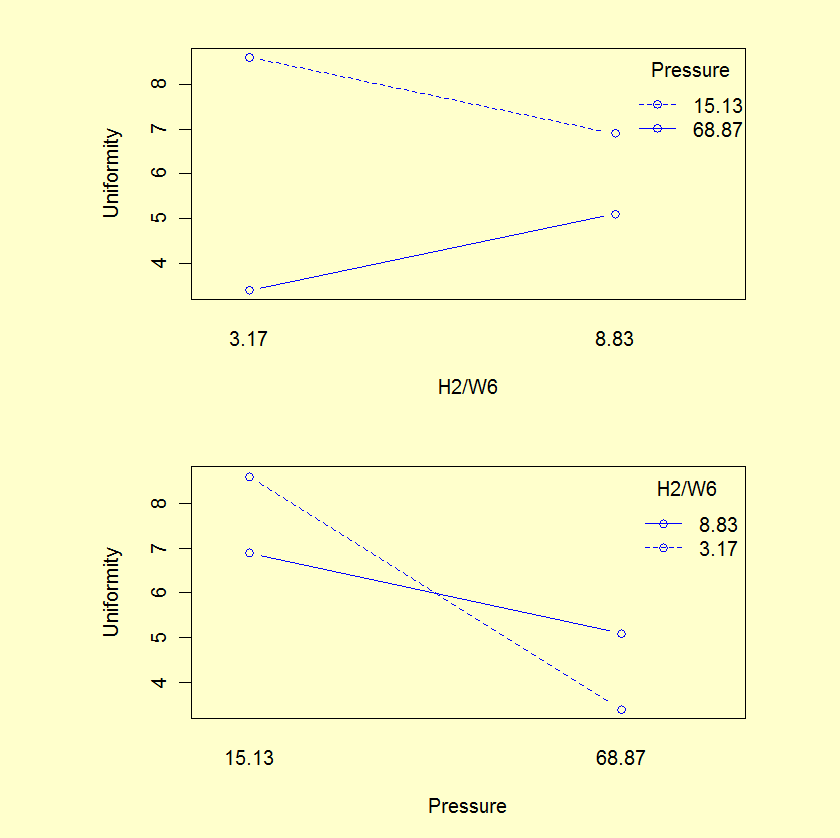
Source DF Sum of Sq Mean Sq F value Pr(>F) ------ -- --------- ------- ------- ------ Model 3 17.739 5.9130 15.66 0.0017 Total error 7 2.643 0.3776 Lack-of-fit 5 1.4963 0.2993 0.52 0.7588 Pure error 2 1.1467 0.5734 Residual standard error: 0.6145 based on 7 degrees of freedom Multiple R-squared: 0.8703 Adjusted R-squared: 0.8148 Source Estimate Std. Error t value Pr(>|t|) ------ -------- ---------- ------- -------- Intercept 5.9273 0.1853 31.993 7.54e-09 Pressure -1.9097 0.3066 -6.228 0.000433 H2/WF6 -0.2241 0.3066 -0.731 0.488607 Pressure*H2/WF6 1.6862 0.6095 2.767 0.027829
A contour plot and perspective plot of Uniformity provide a visual display of the response surface.
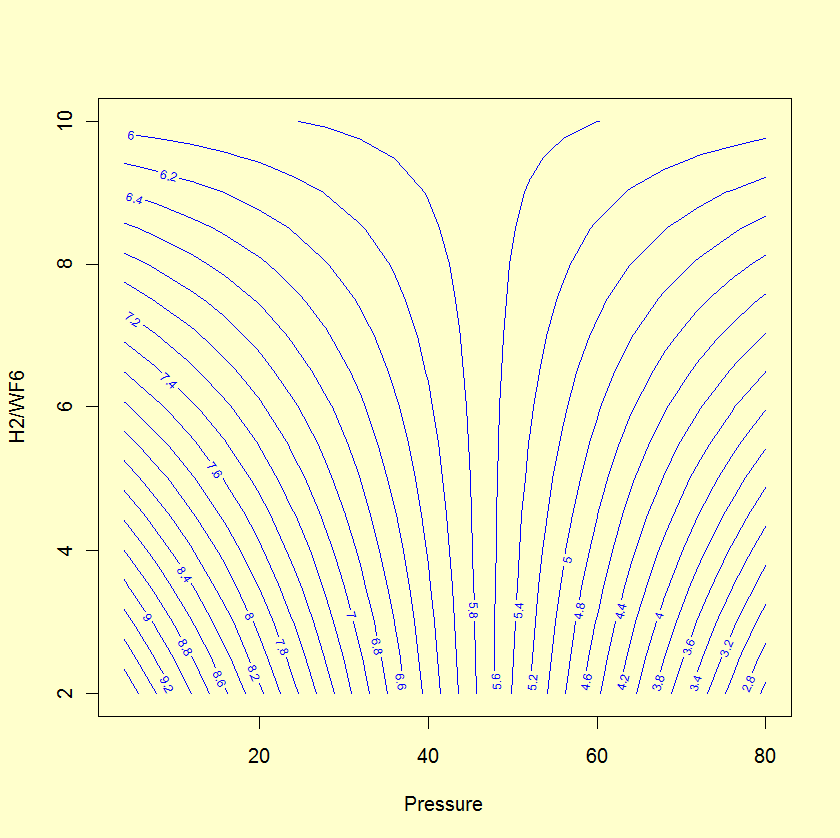

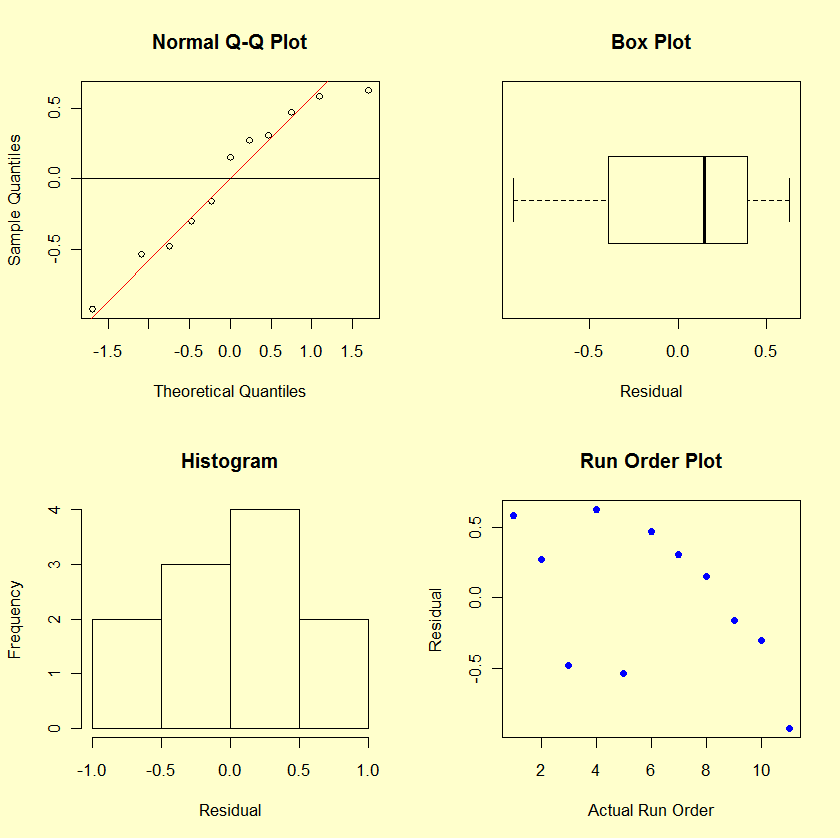
The residual plots do not indicate problems with the underlying assumptions.
- The R2 is reasonable for fitting Uniformity (well known to be a difficult response to model).
- The lack-of-fit test is not significant (very small "Prob > F " would indicate a lack of fit).
- The residual plots do not reveal any major violations of the underlying assumptions.
- The interaction plot shows why an interaction term is needed (parallel lines would suggest no interaction).
Source Estimate Std. Error t value Pr(>|t|) ------ -------- --------- ------- -------- Intercept 8.056791 0.179561 44.869 1.04e-07 Pressure 0.735933 0.038524 19.103 7.25e-06 H2/WF6 0.852099 0.198192 4.299 0.00772 Pressure*H2/WF6 0.069431 0.076578 0.907 0.40616 Pressure^2 -0.528848 0.064839 -8.156 0.00045 H2/WF6^2 -0.007414 0.004057 -1.827 0.12722 Residual standard error: 0.07721 based on 5 degrees of freedom Multiple R-squared: 0.9917 Adjusted R-squared: 0.9834 F-statistic: 119.8 based on 5 and 5 degrees of freedom p-value: 3.358e-05
Start: AIC=-53.02 Model: Stress ~ Pressure + H2/WF6 + Pressure*H2/WF6 + Pressure^2 + H2/WF6^2 Step 1: AIC=-53.35 Model: Stress ~ Pressure + H2/WF6 + Pressure^2 + H2/WF6^2The stepwise routine identifies a model containing the intercept, the main effects, and both squared terms. However, the fit of the full quadratic model indicates that neither the H2/WF6 squared term nor the interaction term are significant. A comparison of the full model and the model containing just the main effects and squared pressure terms indicates that there is no significant difference between the two models.
Model 1: Stress ~ Pressure + H2/WF6 + Pressure^2 Model 2: Stress ~ Pressure + H2/WF6 + Pressure^2 + Pressure*H2/WF6 + H2/WF6^2 Source DF Sum of Sq Mean Sq F value Pr(>F) ------ -- --------- ------- ------- ------- Model 1 2 0.024802 0.01240 2.08 0.22 Model 2 5 0.029804 0.00596In addition, interaction plots do not indicate any significant interaction.

The fact that the stepwise procedure selected a model for Stress containing a term that was not significant indicates that all output generated by statistical software should be carefully examined. In this case, the stepwise procedure identified the model with the lowest AIC (Akaike information criterion), but did not take into account contributions by individual terms. Other software using a different criteria may identify a different model, so it is important to understand the algorithms being used.
Source DF Sum of Sq Mean Sq F value Pr(>F) ------ -- --------- ------- ------- ------- Model 3 3.5454 1.1818 151.5 9.9e-07 Total error 7 0.0546 0.0078 Lack-of-fit 5 0.032405 0.00065 0.58 0.73 Pure error 2 0.022200 0.01110 Residual standard error: 0.0883 based on 7 degrees of freedom Multiple R-squared: 0.9848 Adjusted R-squared: 0.9783 Source Estimate Std. Error t value Pr(>|t|) ------ -------- ---------- ------- -------- Intercept 7.73410 0.03715 208.185 1.56e-14 Pressure 0.73593 0.04407 16.699 6.75e-07 H2/WF6 0.49686 0.04407 11.274 9.65e-06 Pressure^2 -0.49426 0.07094 -6.967 0.000218A contour plot and perspective plot of Stress provide a visual representation of the response surface.
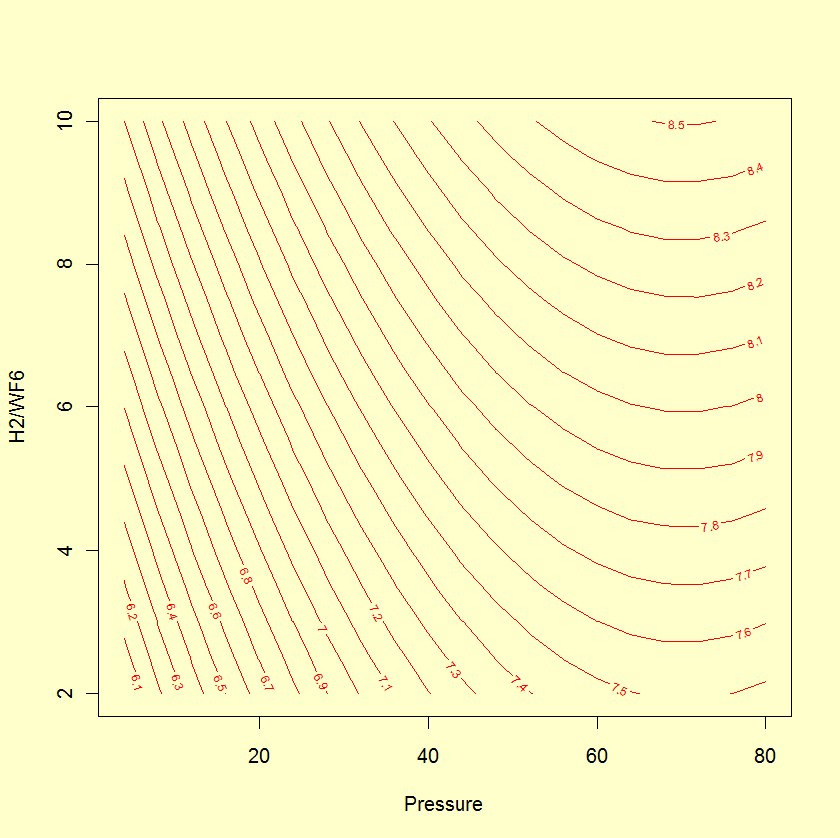


- The R2 is very good for fitting Stress.
- The lack-of-fit test is not significant (very small "Prob > F " would indicate a lack of fit).
- The residual plots do not reveal any major violations of the underlying assumptions.
- The nearly parallel lines in the interaction plots show why an interaction term is not needed.
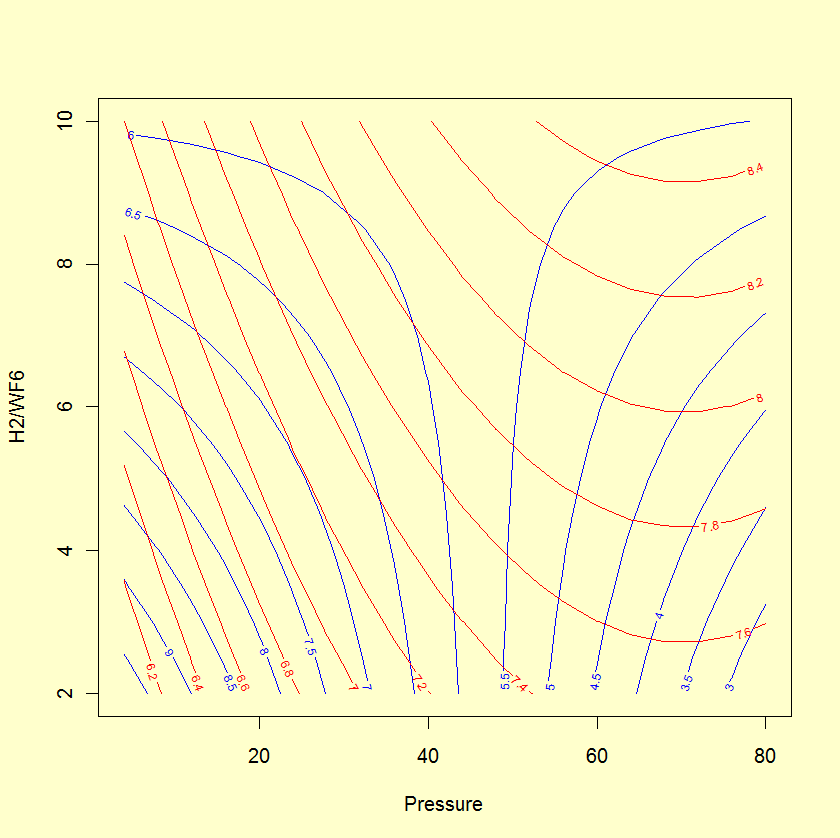
Uniformity = 5.93 - 1.91*Pressure - 0.22*H2/WF6 + 1.70*Pressure*H2/WF6
Stress = 7.73 + 0.74*Pressure + 0.50*H2/WF6 - 0.49*Pressure2

